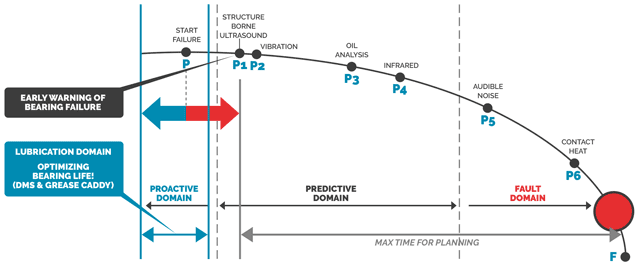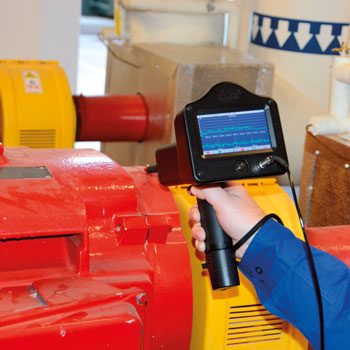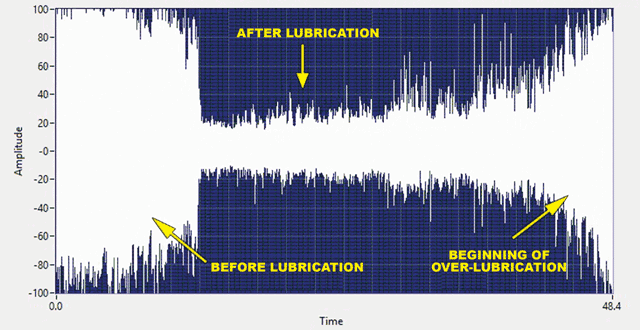
Vibration analysis has been the technology of choice for maintenance professionals to monitor the condition of rotating assets for many years. However, most recently ultrasound has also emerged as a popular technology for condition monitoring. But which one is better? Ultrasound or vibration? Chris Hallum, UE Systems’ Regional Manager for the UK & Ireland, explains the roles of the two technologies in maintenance and reliability practices.
Why vibration analysis?
Vibration analysis is an incredible tool: it detects and measures small vibrations and what is causing them, allowing maintenance professionals to detect early failures. Furthermore, vibration analysis gives us a deep diagnostic and allows us to identify the failure’s root cause. Plus, there is a great number of vibration sensors and solutions in the market to choose from.
Why Ultrasound?
Ultrasound is considered by many the first line of defence when it comes to bearing failures, since it can give a very early warning of a potential problem, even with lubrication issues. The way ultrasound does that is by monitoring the friction levels on rotating equipment. Friction creates ultrasound emissions that can be picked up by an ultrasonic handheld device or sensor and translated to low frequency sounds that the inspector can hear.

Ultrasound or vibration?
There is no easy answer, but one thing is for sure: if a maintenance team wants to reach excellence, both technologies should be used. Ultrasound will provide the earliest warning of failure since it relies on simply trending decibel levels. Vibration analysis is extremely complete and will give maintenance professionals a deep overview of the issue and its root cause.
Almost as if ultrasound is the doctor who detects the problem, and vibration is the health specialist that will diagnose it properly. We will focus on where, in general, ultrasound can be used instead of vibration.
Slow Speed Bearings
Slow speed bearings are difficult to monitor. Since they rotate very slowly, it’s difficult for vibration sensors to pick up significant changes in vibration. Even with an ultrasound instrument it may be difficult to pick up failures if we rely only on decibel levels, since in extreme slow speed bearing applications the bearing will produce little to no ultrasonic noise.
However, high-end ultrasonic devices will allow for sound recording – by recording the sound of the bearing and checking it in a spectrum analysis software, we can easily find peaks in the sound spectrum amplitude, indicating a fault.
First line of defence, easy to use
For a maintenance professional to properly work with vibration analysis, significant training and experience are needed. On the other side, ultrasound has a much quicker learning curve: since it is monitoring friction levels and translating them to dB values, we can easily check for potential problems.

Lubrication
Because ultrasound is based on the friction levels, it is perfect for bearing lubrication. Is the bearing lacking lubrication? Then the friction levels will increase, and we can hear that through the ultrasonic instrument and see it in the dB levels. If we start lubricating the bearing, most likely we will see a decrease in the sound intensity and the dB levels. Did the bearing receive too much lubricant? Then again, friction levels will increase, and we will know that using the ultrasonic instrument.
Versatility
While vibration analysis is an extremely powerful tool, its uses are limited to mechanical equipment. On the other hand, ultrasound has a wide range of applications. One of the most popular applications is energy savings. Since turbulence also creates ultrasound emissions, the ultrasonic instruments can be easily used for leak detection (compressed air and other gases), steam traps inspection and even for electrical inspections.
Conclusion
We believe that using multiple technologies that complement each other is the way to go. Therefore, the question is not ultrasound vs vibration, but instead ultrasound AND vibration and when we should be using one or the other. Both are very powerful condition monitoring technologies and, when used properly together, can really take any maintenance and reliability program to the excellence level.
Christopher Hallum, Regional Manager UK & Ireland – UE Systems
chrish@uesystems.com | +44 (0) 7930 352 188

